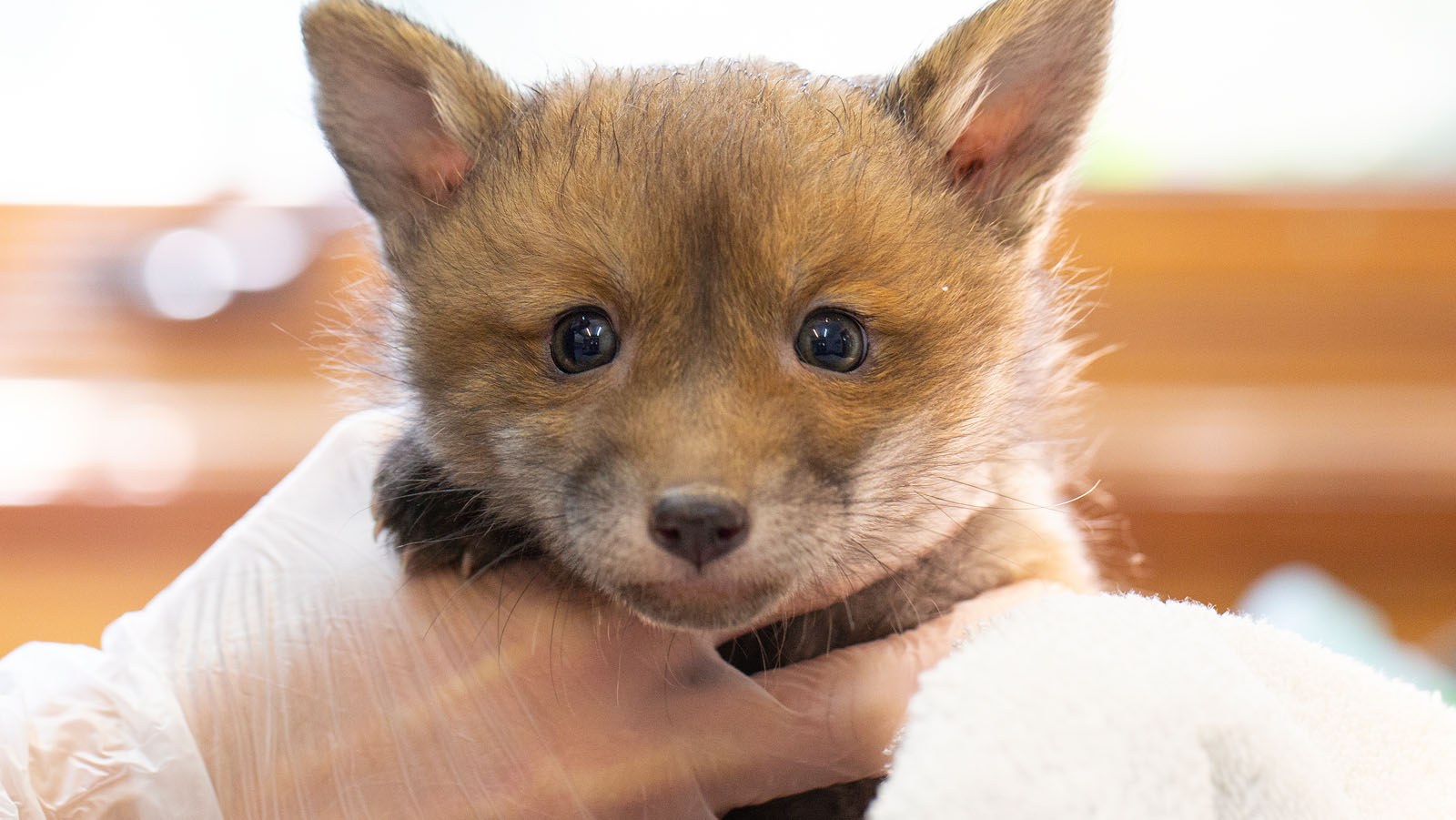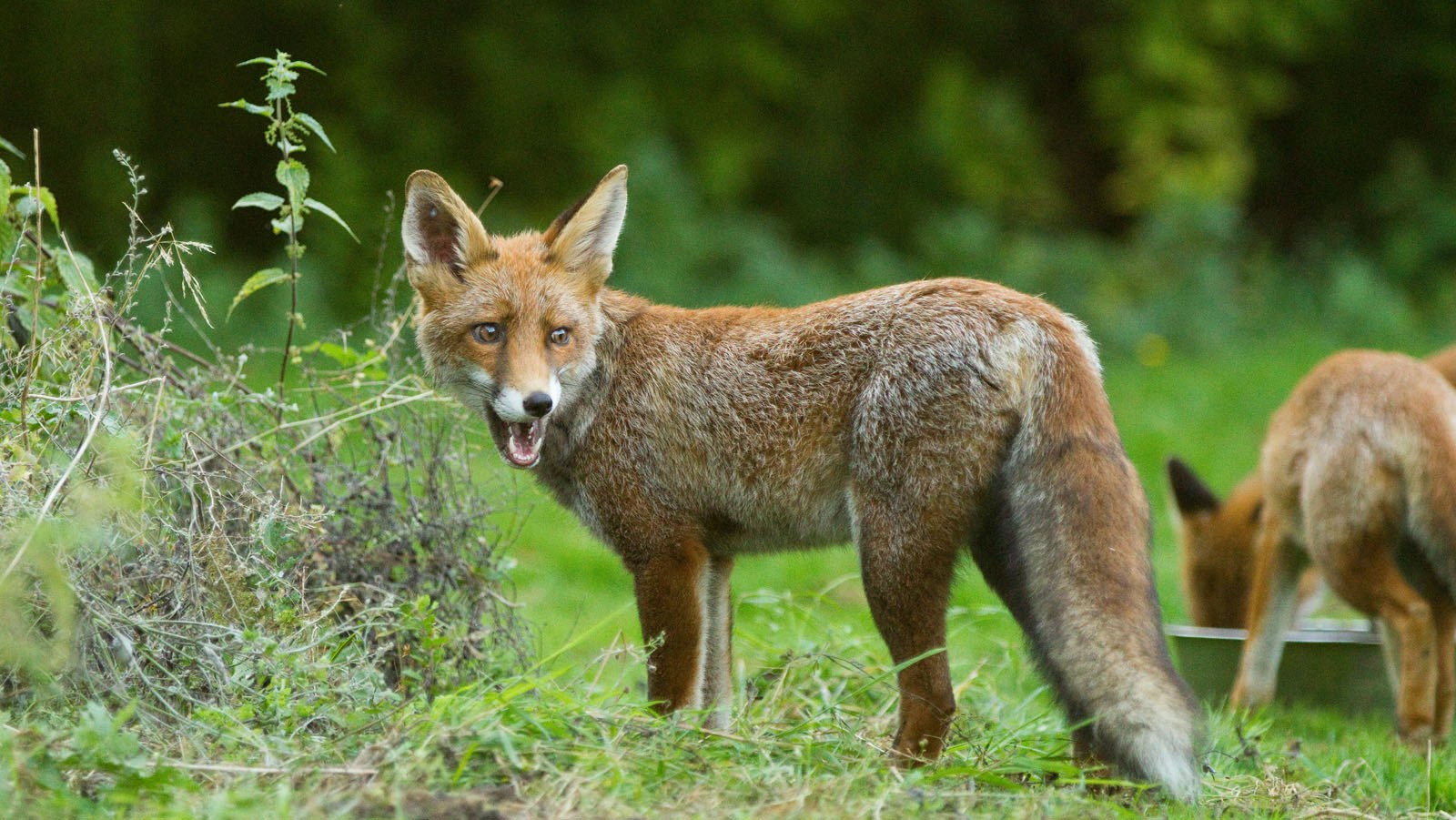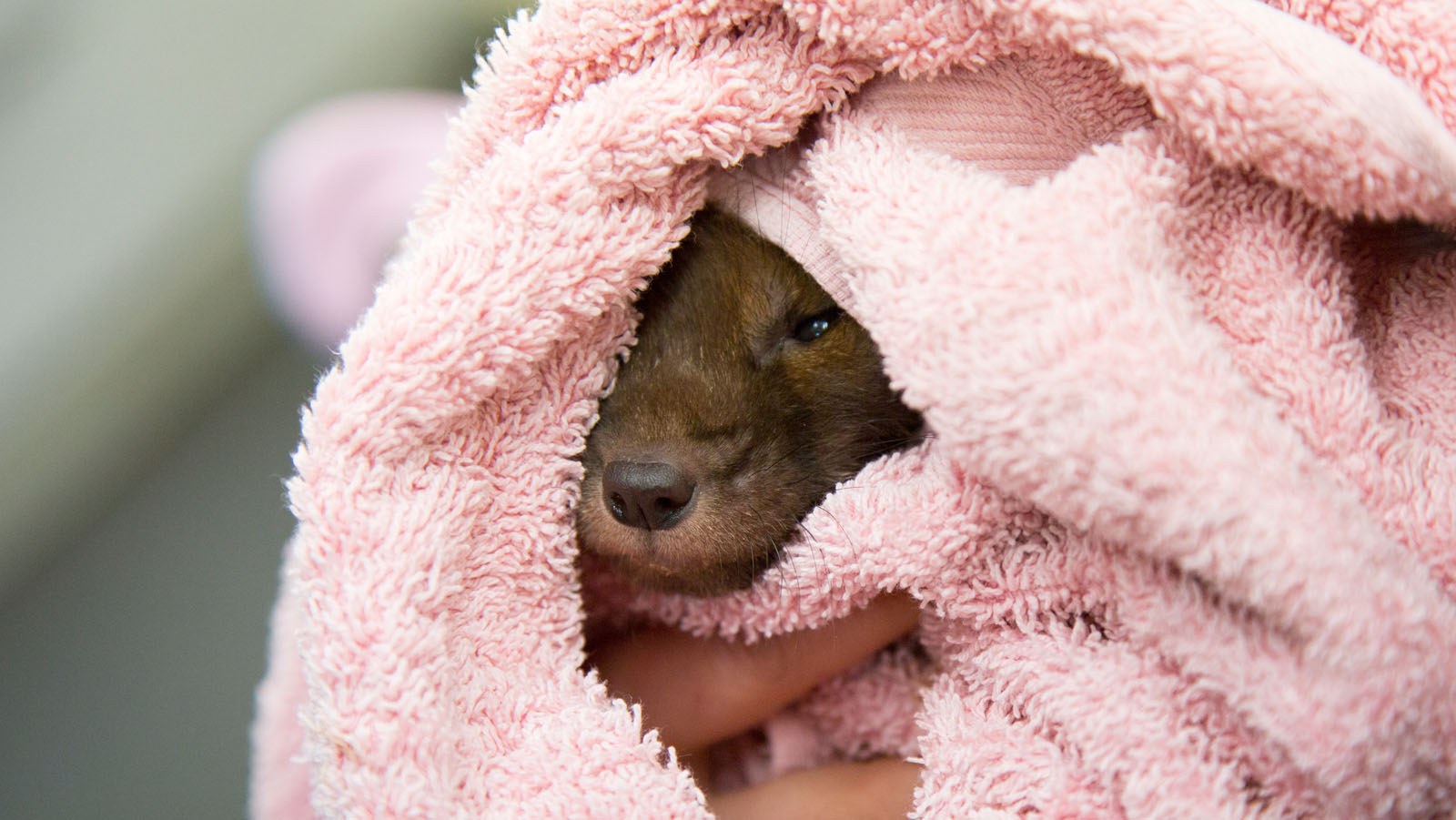Foxes
Check what the injury is. A limping fox, or a fox walking on just three legs, will often be displaying the first signs of mange. They will still be mobile, and will elude capture. Unfortunately, mobile foxes are impossible to catch. We might suggest setting up a feeding pattern and observing it for a week. Food will help the fox to survive while the injury heals. Once they are in a routine, then it’s possible they can be trapped. If it is mange (see following section) then homeopathic food supplement can be added to the food for a few weeks.
Are you already feeding the fox? If not, might you be prepared to do so for the length of the treatment (6-8 weeks)? If so, then a supplement can be purchased from our online shop, here. This supplement is given in food and will help with the fox's overall body condition.
Mange is a skin mite that causes the fox to scratch, and this leads to fur loss and crusty or flaky skin. Often, the first place to lose hair is on the haunches - the hip joints - and then along the back and tail. Scratching at the skin may often cause the skin to bleed, and the fox is then prone to infection, which, if left untreated, can be fatal.
The Homeopathic Food Supplement costs £5.00 per bottle, and can be bought from our reception or our online shop.
If the mange is very advanced, then we can offer you the opportunity to hire a humane fox trap from us. These traps are set for the fox, and baited with food, to entice the fox in. Once in, a door swings shut, enabling the fox to be brought into the hospital for treatment.
Yes, all mammals can contract and suffer from mange. For domestic animals, please, refer to your vet.
Worms can often be seen in the faeces of foxes, and are usually accompanied by weight loss. People who regularly see foxes are likely to notice the difference.
We cannot prescribe medication without seeing the animal.
***NOTE: WE DO NOT HIRE OUT FOX TRAPS DURING ORPHAN SEASON***
Fox traps should be collected from the Wildlife Aid Foundation – they are quite large, so, please, be advised you should have an estate car, at least. Trap hire is £15.00 for the first week, followed by £3.00 per day thereafter, and we also ask for a deposit of £100.00, which is returned when the trap is returned to us. Traps should, ideally, be returned after one week, as it is unlikely the fox will be trapped after this amount of time.
Upon collection of the trap, you will be shown how to set it up by a member of our team.
The trap should be left in the garden, in the area you intend to set it up, for a couple of days before baiting it. This will help to make the fox less wary of it and, hopefully, more willing to investigate inside it when it is baited. Traps must only be left in private NOT communal gardens.
The trap should be set once it starts to get dark, and then un-set before you go to bed, so that the fox, or any other animal that gets in, will not be trapped overnight. Once the fox is trapped, have a couple of blankets handy to throw over the cage to keep the animal calm.
Once the CORRECT fox is trapped, please call us on 01372 360404, immediately, to come and collect it.
Every year, we receive many calls from people who have seen two foxes 'stuck together' and worry that they are injured or are the victims of cruelty. Please, rest assured that this 'tie' is a natural part of the fox breeding process and they will separate by themselves, in time.
They can be ‘tied’ together for a significant amount of time and should just be left alone!
There may not necessarily be anything wrong; foxes often find quiet places to lie down, during the day, and they do enjoy the sunshine. They will often pick a shed or garage roof, and curl up where it is warm. If you have a pair of binoculars, you can check it from a distance to see if it is showing any signs of injury or distress. The broom test could be used to see if the fox is injured or just relaxing! The broom test is to gently touch the animal with a broom handle – most won’t let you get near enough to do so. If, however, you’re able to get close enough to touch the animal with a broom handle and it doesn’t move, then, please, call us on 01372 360404 for advice.
There is a fox with cubs in my garden and I have young children/pets etc. – I don’t want them there…
As a hospital, we only treat sick and injured wildlife, and do not get involved in the relocation of healthy animals. There are some companies that do offer relocation services (and charge for it!), but once foxes are removed, more foxes will probably move in, so a deterrent is often the best approach.
Foxes have territories and your garden has become part of theirs. The trick is to make them feel unwelcome in your garden. Often, this can be as simple as throwing a bucket of water over them or banging dustbin lids together to scare them off. You may have to repeat this for a few nights, but they are intelligent creatures and will soon get the message.
If there is a family of foxes in the garden, then the same principle applies. Use deterrents and scare tactics to encourage the mother to move the cubs. If the environment she is in becomes intimidating, then she will soon take her family elsewhere. Don’t forget that a vixen on her own can easily scale a 6’ fence, but with a cub in her mouth she may not be able to. Give her an easy path out of the garden by leaving a gate open, removing a fence panel, or placing a ramp up to the fence so she can climb up more easily.
If the fox has a den under the shed, or similar, a simple trick for encouraging the family to leave is to dig over the earth outside the den, every night. This will give the impression that something is trying to get into the den and take the cubs, and Mum will, hopefully, then move them on.
Due to man’s encroachment on their natural habitat, foxes are being driven in larger numbers into our towns and cities. Over the last 10 years, they have become a normal sight to many of us, and people have taken to feeding them in their gardens. Unfortunately, however, this means that foxes are losing their natural fear of humans, and are learning that wherever we are there is bound to be food!
By encouraging foxes into our gardens, we are teaching them that it is okay to be there. As our houses are simply an extension of our gardens to them, it is unsurprising that foxes have been known to venture inside houses, especially if there is a tempting smell inside. Sadly, we have seen too many cases of one person feeding foxes in their garden, only for their neighbour to put down poison or injure the same animal.
We would suggest, unless you are giving foxes medication, you do not feed them; they have natural hunting instincts and will survive on mice, rats, birds and other small prey and will not starve. They are wild animals, and by feeding them we are teaching them to rely on us. When they have their cubs, those cubs will start to think that food comes in a bowl, in a garden, and will not have the strong hunting instincts that they should have, as a wild animal.
Fox cubs
The fundamentals of what you should and shouldn’t do when finding a fox cub.

More about fox cubs
Fox cubs are born between January and March. For the first couple of weeks, their eyes are closed and they remain in the earth, with both parents going for food and returning to feed them. Often, the mother will move the cubs from the birthing earth to a new earth, to avoid predators smelling where the cubs are. She will carry each cub in her mouth and move them, one by one. If she gets disturbed, she may drop a cub, but she will generally come back for it, so it should be left well alone until there is no doubt that she isn’t going to return.
The main carer is Mum and, once the cubs are slightly bigger, she will leave them alone to go and search for food, and may not return to the earth for a few hours at a time. Once the cubs are slightly bigger and their eyes start to open, they will become more vocal and more adventurous, and may start to emerge from the earth, calling for Mum.
This is the point at which most fox cubs are found by people, and this is the time we need to be most careful with our advice. Too many perfectly healthy fox cubs are picked up and brought to us, unnecessarily, when they are just starting to explore and are getting hungry (which may make them whimper a little). It’s only if they start to appear dehydrated or they are in mortal danger (by the side of a road, by a river, soaking wet in the rain, etc.) that we should intervene. Even then, please, speak to us, first, before you do anything. We will most likely ask you for a photo, so we can assess the age of the cub. We can then attend the scene, review the situation, and make the critical decision as to whether to separate that cub from the probable return of its mother.
If we remove cubs from a mother who is still healthy, then we risk the mother getting mastitis, which is a painful and sometimes fatal condition. All possible steps must be taken to avoid separating cubs from their mother.
Fox cubs are, usually, fully weaned by June, and over the summer and into September they will gradually separate from their parents and siblings and establish their own territory.
Here are some of the most common calls we get about fox cubs:
Firstly – don’t touch it! It’s probably a fox cub – fox cubs do not look at all like foxes when they are very young. When fox cubs are born, they are a dark chocolate brown and look very like small kittens or puppies. If in doubt, call us and send us a photo. Observe the youngster from the house for a while, as the vixen might have been disturbed while moving her cubs to a new den. If she does not appear after several hours and the cub is getting distressed, please, call us back. If the cub is not distressed but the weather is cold, provide a cardboard box for shelter, but do not handle the cub (if you must handle the cub, do so wearing gloves that you’ve, first, rubbed in soil, to avoid leaving any human scent on the youngster).
Is it making a noise and wandering about? This is a sign it is distressed or hungry and it may have wandered away from its den in search of its mother. Observe until dusk, when the vixen should come back. Do not handle the cub unless it is obviously injured and needs assistance. If the weather is very cold and/or wet, provide some shelter (a box on its side with some bedding), if possible, and observe, as before. If you’re unsure, we can send someone experienced to have a look. Please do call us before handling the cub.
No! Never, never pick up a fox cub with your bare hands – apart from running the risk of a nasty nip, the smell of humans on a cub can lead to the mother abandoning it.
If you are 100% sure that the dead fox is the cubs’ mother, then bring the cubs to us, immediately. Keep them together in a box, and make sure they are warm. If you are not sure, then, please, keep the den under observation. If the mother does not return, the cubs may well leave the den and start wandering around, crying and looking for her. At this point, please, call us again.
Repellents and deterrents
Ethical deterrents that you can carry out yourself
- Throw a bucket of water over the fox every time it comes in the garden.
- Fill a tin can with stones and rattle it.
- Bang saucepan lids/dustbin lids etc. together.
- Foxes do not like the scent of male human urine…
Essentially, make the fox feel unwelcome every time it ventures too close. It will not be an overnight solution, but, over time, it will get the message.

Useful telephone numbers
The Fox Project (SE England) - Admin: 01892 824111 / Emergency: 01892 731565
National Fox Welfare Society - 01933 411996
Humane Wildlife Solutions - 07771 361226
